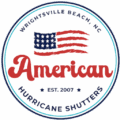The Unsung Heroes: Why Shutter Anchors and Tracks are Critical
When you look at a hurricane shutter system, your eye is naturally drawn to the big, visible part—the strong aluminum panel, the solid accordion blade, or the sleek rolldown curtain. But the true strength of any storm protection system lies in the parts you might not notice: the anchors that bind it to your home and the tracks that hold it in place. These components are the unsung heroes of hurricane protection.
A shutter is only as strong as its connection to the house. At American Hurricane Shutters, we know that a professional installation isn’t just about hanging a product; it’s about creating a structurally sound, integrated system. This guide will take you behind the scenes to understand the critical importance of anchors and tracks and why their correct installation is a matter of science, not guesswork.
The Science of Anchoring: Holding Fast Against Incredible Force
During a hurricane, your shutters are subjected to thousands of pounds of pushing and pulling force from the wind. The job of the anchor is to transfer that immense load from the shutter into the structural frame of your home. If the anchor fails, the entire shutter system fails.
Different Walls, Different Anchors
There is no one-size-fits-all anchor. The type of fastener required is entirely dependent on the material of your home’s exterior walls. Using the wrong one is a recipe for disaster.
- Concrete Block or Poured Concrete: For these very common coastal construction types, we use specialized **concrete sleeve anchors** or **wedge anchors**. These expand once inside the concrete, creating a powerful friction grip that provides immense holding power.
- Wood Frame Construction (with Siding or Stucco): For wood-framed homes, it is absolutely critical to locate the structural studs (typically 2×4 or 2×6 lumber). We use long, heavy-duty **lag screws** that are drilled through the exterior sheathing and deep into the solid wood of these studs. Anchoring only to the siding or plywood sheathing will fail.
- Brick Veneer: This is the trickiest and where expertise is most critical. We must drill through the brick and use an extra-long fastener that anchors securely into the structural wood frame or concrete block *behind* the brick. Anchoring just to the brick itself is dangerous, as the brick is not structural.
Engineering a Secure Connection
The product’s engineering approval specifies the exact type, diameter, length, and spacing of the fasteners. A professional installer follows these specifications to the letter. Many other installers in the area do not use the correct fastener length and material for our coastal town where most of the framing is in wood. We use only #14 and 5/16″ 18-8 stainless steel fasteners, coupled with the correct lengths of 3.5″ (for most siding), 5.5″ (if buildout is needed for clearance), and 7 6/8″ for brick veneer. Plus we are the only local company using ELCO BiFlex self-drilling screws. These are the only self drilling screws on the market with a stainless steel head, which will resist corrosion, ensuring long-lasting protection and mechanical pull-out resistance when buildout is needed. Do not accept TapCon carbon steel anchors- which deteriorate in no time on the coast. This is a core part of our installation process and is what ensures the system will perform as it was designed and tested to do.
The Framework of Protection: Understanding Shutter Tracks
While anchors provide the connection, the tracks provide the framework that holds the shutter blades in place and channels the wind load to the anchors.
Tracks for Storm Panels
For our removable storm panel systems, the track is what makes installation fast and easy. Common types include:
- H-Header and F-Track: A header track is mounted above the window, and a floor track is mounted below. The panels slide into the tracks from the side. This is a very strong and popular mounting method.
- Direct Mount Anchoring: For this method, individual anchors with threaded studs are installed around the window. The panels have holes that line up with these studs and are secured with wing nuts.
Tracks for Accordion and Roll-Down Shutters
For our permanently installed accordion and rolldown systems, the tracks are a permanent fixture. They are made of heavy-duty extruded aluminum and are meticulously installed to be perfectly level and plumb. This not only ensures the structural integrity of the system but also guarantees that the shutter will glide smoothly and operate flawlessly for decades. A track that is even slightly out of alignment can cause the shutter to bind and become difficult or impossible to close.
Why Professional Installation is the Only Safe Option
This deep dive into the science of anchors and tracks should make one thing abundantly clear: this is not a DIY project. The expertise required to select the correct fastener, locate structural members, and install tracks with precision is something that only comes with extensive training and experience.
When you hire American Hurricane Shutters, you are investing in the peace of mind that comes from knowing every single screw, anchor, and track is installed to the highest possible standard of safety and quality. We are a fully insured, family-owned business, and our reputation since 2007 is built on this commitment to doing the job right, every single time.
Trust the Foundation of Your Protection to the Experts
Don’t let the most critical component of your storm protection be an afterthought. Ensure your shutters are anchored by the knowledge and experience of seasoned professionals.
Call American Hurricane Shutters today at (910) 256-1288 or email the owner, Matthew Burns, at [email protected] to schedule a free consultation and learn more about our uncompromising commitment to safety.
